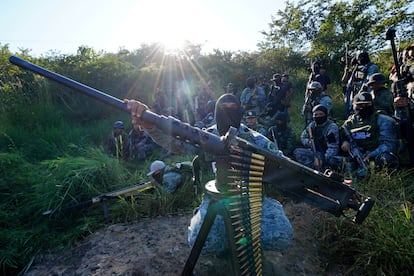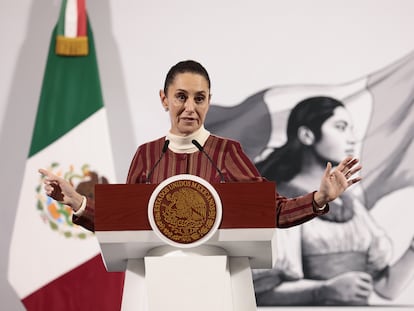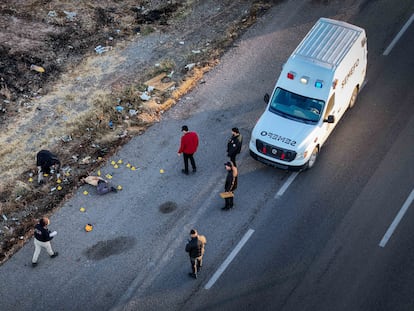Beyond the drug lords of Sinaloa and Jalisco: Trump’s blacklist designates six Mexican cartels as terrorist organizations
The White House is outlining, pending a formal announcement, the first designations: La Familia Michoacana, Cárteles Unidos, Cartel del Noroeste and the Gulf Cartel are on the list, according to ‘The New York Times’

The first designations of Mexican cartels as terrorist groups are on the table. The Donald Trump administration is targeting the Sinaloa Cartel and the Jalisco New Generation Cartel (CJNG), two of the most powerful criminal forces in the world, for a first round of sanctions, The New York Times reported. Pending an official announcement, other organizations with extensive influence in Mexico are also on the blacklist, such as La Familia Michoacana, the Gulf Cartel and the Cartel del Noreste (CDN), a splinter group of Los Zetas, as well as Cárteles Unidos, an amalgam of cells that operate in the south of the country. The paradigm shift heralds an unprecedented chapter in more than six decades of the war on drugs.
Trump issued an executive order on January 20, his first day in office, to designate drug cartels as terrorist organizations, elevating the threat of drug trafficking to the orbit of national security and making available to the U.S. military the tools designed for the “war on terror” initiated during the presidency of George W. Bush. The executive action contemplates that the State Department will propose who will be targeted by sanctions and submit the list to the consideration of Congress, which has a Republican majority. The deadline for Marco Rubio, the head of U.S. diplomacy, to formulate the recommendations was 14 days and has already been met. Official sources cited by The New York Times anticipate that the announcement will be made in a matter of days.
Mexican cartels are not the only targets in Washington’s sights. Trump’s executive order also names El Salvador’s Mara Salvatrucha and Venezuela’s Tren de Aragua. Colombia’s Gulf Clan is another of the groups that is being considered. U.S. law provides that the criminal organizations have a period of 30 days to appeal the designations, which is highly unlikely given it is very rare for their leaders to publicly present themselves as such. The foreseeable consequences are more intense monitoring of the financial structures of the cartels, greater discretion in the operating margin of U.S. agencies, and broader intelligence operations under the supervision of the Pentagon. The Mexican government is on edge about possible violations of its sovereignty, under the excuse of the the war against terrorism.
The Sinaloa Cartel: a fragmented empire
“The Sinaloa Cartel is Mexico’s largest criminal organization,” says analyst David Saucedo, “but it has many heads, it’s a fragmented empire.” The country’s most well-known and powerful criminal group is at a critical moment and has been waging an internal war since last September, centered on the two families that have held the reins of the cartel for decades: the faction loyal to Ismael “El Mayo” Zambada and Los Chapitos, led by the sons of Joaquín “El Chapo” Guzmán. Zambada accuses Joaquín Guzmán López, his godson and one of El Chapo’s heirs, of kidnapping him and handing him over to the United States. The alleged betrayal is at the heart of the internal battle. Sinaloa, the historic stronghold of the eponymous group, has recorded more than 800 murders since the outbreak of the conflict, as well as hundreds of missing persons, according to official data.
The Drug Enforcement Administration (DEA) says the cartel has a presence in more than 50 countries and connections to mafias, insurgent groups and criminals on five continents. Even before the capture of El Mayo last July, U.S. authorities had launched a judicial offensive against the leaders of the organization, part of a hunt that has spanned generations and that now has as its main targets brothers Iván Archivaldo Guzmán and Jesús Alfredo Guzmán, as well as Ismael Zambada Siquieros, alias “Mayito Flaco,” Zambada’s son. The uncertain future of the cartel has raised questions about the strategy that Washington will follow to combat it. “The U.S. government will have to make a decision: will it turn against El Mayo or against Los Chapitos? It is not clear,” says Saucedo.
The Jalisco New Generation Cartel: Mencho’s people
The CJNG is the Sinaloa Cartel’s biggest rival. Unlike the turmoil among the leadership of its enemies, the Jalisco New Generation Cartel has Nemesio Oseguera Cervantes, alias “El Mencho,” as its undisputed leader. The White House is offering $15 million for his head. Rubén Oseguera, “El Menchito,” his son and successor, was found guilty of drug trafficking and illegal use of firearms in Washington last year. El Mencho has an alliance with Los Cuinis, a parallel structure led by his in-laws, which operates as his armed and financial wing.
Founded just over a decade ago, the CJNG is one of the fastest-growing groups in the country, thanks to a franchise model that delegates each phase of drug trafficking to a specialized link in its criminal chain. Saucedo points out that this has allowed them to seize several territories from their adversaries, such as Tabasco, Chiapas and Zacatecas. Much has been said about the changes that the Sinaloa war could bring about in Mexico’s criminal geography and whether the CJNG will be one of the main beneficiaries, and whether this eventual rise will place them more in the sights of the authorities. The organization was behind the 2020 attack against Omar García Harfuch, the security czar of Claudia Sheinbaum’s government.
The (new) Familia Michoacana
La Familia Michoacana played a huge role in the early years of the war on drugs launched by the government of Felipe Calderón (2006-2012). The group was founded by Nazario Moreno, an enthusiastic evangelical who prohibited the consumption of alcohol and drugs and imposed a strict code of conduct on his men. “He demanded a monastic life from them,” says Saucedo. Moreno “died” twice: it was reported that he was killed in a shootout with the Navy in 2010, although other versions indicated that he was still alive and in charge of the criminal group until his death was confirmed in 2014 in another confrontation with the Mexican marines. The group fractured: one part kept the name and another allied itself with the Sinaloa Cartel and adopted the name of Los Caballeros Templarios.
“It is the third-largest macrocriminal group in the country,” Saucedo says of the heirs of La Familia. The specialist points out that the group has a broader portfolio of criminal activities than their Sinaloa and Jalisco rivals, less focused on drug trafficking and more on activities such as extortion. The organization has a presence in the central-southern region of the country, in states such as Michoacán, Guerrero, Morelos, and the State of Mexico. It is led by brothers José Alfredo and Johnny Hurtado Olascoaga, alias “El Fresa” and “El Pescado.”
Cárteles Unidos: narco-insurgency and “paying of dues”
The least known of the list, Cárteles Unidos, also has its origins in Michoacán and a large presence in Guerrero. It emerged as a coalition of small criminal groups, local mafias, and self-defense groups, such as Los Viagras, the Tepalcatepec Cartel, and Los Caballeros Templarios. “They first joined forces to confront the invasion of Los Zetas and when they exterminated them, they did so again to repel the Jalisco New Generation Cartel in Michoacán,” explains Saucedo. The clashes have devastated the region known as Tierra Caliente, one of the most violent in the country. Control of that state has been an obsession for El Mencho, who is originally from there and sees it as a natural expansion zone, having his main headquarters in neighboring Jalisco.
The alliance has followed the example of long-standing organizations like La Familia Michoacana, which saw an opportunity to extort farmers who have benefited from the trade boom with the United States. Michoacán is one of the main producers of avocados, a multimillion-dollar business across the border. But it is also the state that produces the most lemons in Mexico. Cárteles Unidos was behind a recent wave of collecting “derecho de piso,” or paying of dues, from lemon growers, the fee that drug traffickers demand from farmers to keep their businesses going. Washington has closely followed the expansion of these extortions, even suspending trade in threatened industries, which may explain why the coalition was included on the list.
The Cartel del Noroeste and the Gulf Cartel: pending accounts
Founded in the border state of Tamaulipas, the Gulf Cartel is one of Mexico’s oldest criminal organizations. Its origins date back to the years of prohibition and whisky-trafficking in the 1930s, but its presence catapulted after it sealed a protection pact with law enforcement in Mexico and an alliance with Colombia’s Cali Cartel in the late 1990s, under the command of Osiel Cárdenas Guillén, alias “El Mata Amigos.” The capo has just served a 21-year prison sentence in the United States, but was deported last December to face the cases he has open in Mexico. The group was behind the kidnapping of four American citizens in 2023 in Matamoros, a high-profile case that strained bilateral relations.
Cárdenas Guillén was a key figure in the creation of Los Zetas, originally an elite force of the Gulf Cartel. The breakup occurred in 2010, the same year the capo pleaded guilty and was sentenced for drug trafficking in Texas. The Cartel del Noreste is, in turn, a split from Los Zetas, formed after the capture of Alejandro Treviño “El Z-42,” one of its last leaders, in 2015. “The organization has endured and is in charge of a wide range of criminal activities on the border, which has given it visibility in the United States,” says Saucedo.
“I see a lot of bias in these designations. They left out many that are very violent, but that have not received much attention from the United States,” says the specialist, who questions the effectiveness of the new measures and the strategy of going after the leaders of the organizations. “It is a movie that we have already seen: the United States is embarking on a path that it already took in Colombia and that did not lead anywhere.”
Sign up for our weekly newsletter to get more English-language news coverage from EL PAÍS USA Edition
Tu suscripción se está usando en otro dispositivo
¿Quieres añadir otro usuario a tu suscripción?
Si continúas leyendo en este dispositivo, no se podrá leer en el otro.
FlechaTu suscripción se está usando en otro dispositivo y solo puedes acceder a EL PAÍS desde un dispositivo a la vez.
Si quieres compartir tu cuenta, cambia tu suscripción a la modalidad Premium, así podrás añadir otro usuario. Cada uno accederá con su propia cuenta de email, lo que os permitirá personalizar vuestra experiencia en EL PAÍS.
¿Tienes una suscripción de empresa? Accede aquí para contratar más cuentas.
En el caso de no saber quién está usando tu cuenta, te recomendamos cambiar tu contraseña aquí.
Si decides continuar compartiendo tu cuenta, este mensaje se mostrará en tu dispositivo y en el de la otra persona que está usando tu cuenta de forma indefinida, afectando a tu experiencia de lectura. Puedes consultar aquí los términos y condiciones de la suscripción digital.
More information
Archived In
Últimas noticias
Charles Dubouloz, mountaineering star, retires at 36 with a farewell tour inspired by Walter Bonatti
From the White House to diplomatic gifts: Lego wins over adult fans, brick by brick
Kate Winslet makes her directorial debut: ‘There aren’t more female directors because we’re busy raising children’
ChatGPT fails the test: This is how it endangers the lives of minors
Most viewed
- Families demand repatriation of bodies of Colombians who died in Ukraine: ‘This war is a slaughterhouse for foreigners’
- The low-cost creative revolution: How technology is making art accessible to everyone
- Liset Menéndez de la Prida, neuroscientist: ‘It’s not normal to constantly seek pleasure; it’s important to be bored, to be calm’
- Christian Louboutin: ‘Young people don’t want to be like their parents. And if their parents wear sneakers, they’re going to look for something else’
- Christmas loses its festive spirit: ICE fears cast shadow over religious celebrations











































